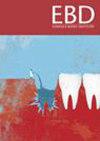Application of pulp tissue genetic profile in orthodontic tooth movement: a needle in a haystack?
Q3 Dentistry
引用次数: 0
Abstract
Zhao Z, Attanasio C, Zong C, Pedano M S, Cadenas de Llano-Pérula M. How does orthodontic tooth movement influence the dental pulp? RNA-sequencing on human premolars. Int Endod J 2024; 57: 1783–1801. Sample selection - The study sample consisted of healthy individuals requiring extraction of maxillary or mandibular premolars for fixed appliance orthodontic treatment. Exclusion criteria included systemic diseases, a history of smoking, antibiotic or analgesic use within the past three months, periodontal probing depths greater than 3 mm, alveolar bone resorption, and premolars with prior endodontic treatment. Participants were randomly divided into 3 groups: control, 7-day, and 28-day groups. Extractions were performed prior to orthodontic treatment, and 7 days and 28 days after application of orthodontic forces (OF) in the control, 7-day and 28-day group respectively. The applied orthodontic forces were in the range of 50–150 g. RNA extraction from pulp tissues was performed using the RNeasy mini kit. After total RNA extraction, a library was prepared, and RNA sequencing was conducted to examine and compare the genetic data among the groups within each jaw. Differentially expressed genes (DEGs) were identified in the 7-day and 28-day groups, followed by functional enrichment analysis to understand their biological significance. Furthermore, protein-protein interaction network analysis was conducted to investigate the complex network of protein interactions and locate key genes involved in orthodontic tooth movement. Immune response, hypoxia, DNA damage, and epigenetic regulation were the pulpal reactions reflected after 7 days of OF. Whereas, at 28 days, processes such as cell adhesion, migration, organization, and tissue repair became prominent. Pulp tissues in the maxilla and mandible responded differently to orthodontic force. The maxilla showed minimal changes, primarily involving immune response at 7 days and tissue repair at 28 days. In contrast, the mandible exhibited significant DNA damage and epigenetic regulation at 7 days, with a return to its baseline condition by 28 days. Dental pulp demonstrated different reactions at 7 and 28 days, with maxillary and mandibular pulp tissues presenting distinct responses. The study provided knowledge about gene regulatory mechanisms modulating pulp tissue response to OF.牙髓组织基因图谱在正畸牙齿运动中的应用:大海捞针?
赵忠,Attanasio C, Zong C, Pedano M S, Cadenas de llano - psamrua M.正畸牙齿移动对牙髓的影响人类前磨牙的rna测序。Int end J 2024;57: 1783 - 1801。设计-横断面设计:样本选择-研究样本包括需要拔除上颌或下颌前磨牙进行固定矫治治疗的健康个体。排除标准包括全身性疾病、吸烟史、过去三个月内使用过抗生素或止痛药、牙周探探深度大于3mm、牙槽骨吸收、前磨牙既往接受过牙髓治疗。参与者随机分为3组:对照组、7天组和28天组。对照组、7天组和28天组分别在正畸治疗前、使用正畸力(orthodontic force, of)后7天和28天进行拔牙。施加的正畸力在50- 150g之间。使用RNeasy迷你试剂盒从牙髓组织中提取RNA。提取总RNA后,建立文库,并进行RNA测序,检查和比较各颌骨内各组间的遗传数据。数据分析:在7天组和28天组中鉴定差异表达基因(differential expressed genes, DEGs),并进行功能富集分析,了解其生物学意义。此外,通过蛋白质-蛋白质相互作用网络分析,研究蛋白质相互作用的复杂网络,定位正畸牙齿移动的关键基因。结果:7 d后的牙髓反应主要表现为免疫应答、缺氧、DNA损伤和表观遗传调控。然而,在第28天,细胞粘附、迁移、组织和组织修复等过程变得突出。上颌和下颌骨的牙髓组织对正畸力的反应不同。上颌骨的变化很小,主要是第7天的免疫反应和第28天的组织修复。相比之下,下颌骨在第7天表现出明显的DNA损伤和表观遗传调控,并在第28天恢复到其基线状态。结论:牙髓在第7天和第28天表现出不同的反应,上颌和下颌牙髓组织表现出明显的反应。本研究提供了关于牙髓组织对OF的基因调控机制的知识。
本文章由计算机程序翻译,如有差异,请以英文原文为准。
求助全文
约1分钟内获得全文
求助全文
来源期刊

Evidence-based dentistry
Dentistry-Dentistry (all)
CiteScore
2.50
自引率
0.00%
发文量
77
期刊介绍:
Evidence-Based Dentistry delivers the best available evidence on the latest developments in oral health. We evaluate the evidence and provide guidance concerning the value of the author''s conclusions. We keep dentistry up to date with new approaches, exploring a wide range of the latest developments through an accessible expert commentary. Original papers and relevant publications are condensed into digestible summaries, drawing attention to the current methods and findings. We are a central resource for the most cutting edge and relevant issues concerning the evidence-based approach in dentistry today. Evidence-Based Dentistry is published by Springer Nature on behalf of the British Dental Association.
 求助内容:
求助内容: 应助结果提醒方式:
应助结果提醒方式:


